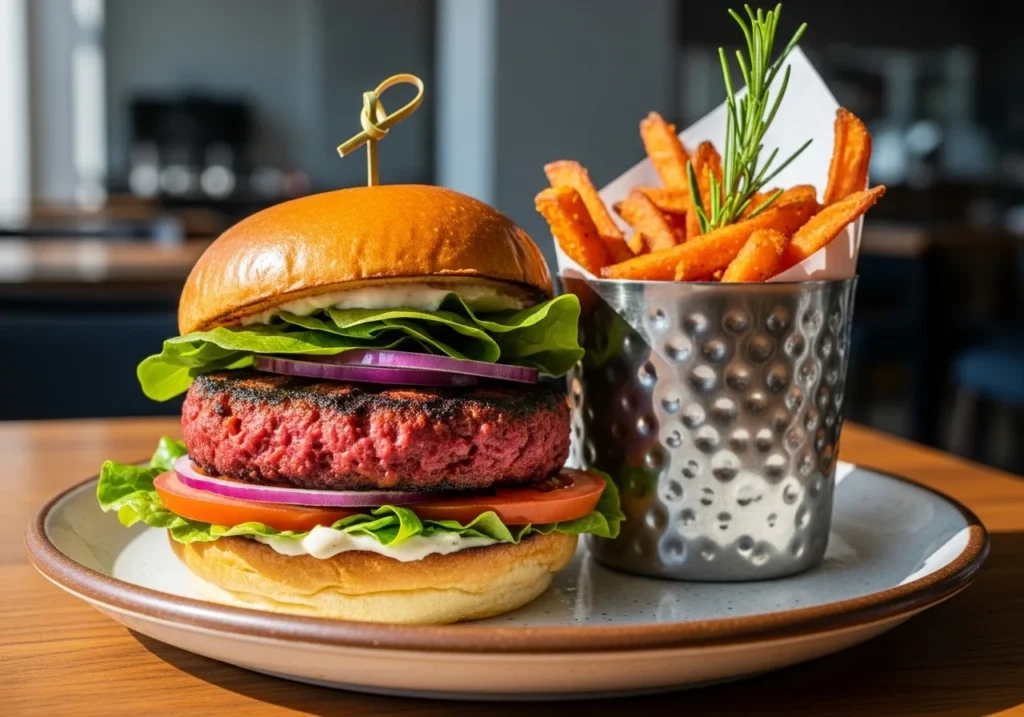Table of Contents
Introduction
The rise of plant-based meat has been presented as nothing short of a modern miracle. Pitched as the guilt-free burger, a high-tech fix for a broken food system, and a clean-conscience solution for the modern consumer, it promised to solve our dietary, ethical, and environmental dilemmas in one fell swoop. The narrative was compelling and powerfully simple: we could have our meat and eat it too, all while saving the planet. This utopian vision fueled a multi-billion-dollar industry, placing products from brands like Impossible Foods and Beyond Meat into grocery carts and restaurant menus worldwide, fundamentally altering the conversation around the future of food.
But behind the billion-dollar valuations and sleek marketing lies a more complex and unsettling truth. The reality of the plant-based meat industry is less about idyllic fields of peas and soy and more about industrial alchemy, culinary psychology, and supply-chain vulnerabilities. The story we’ve been sold is a carefully engineered façade, concealing a highly processed, financially driven machine that has profound and often unintended consequences. Rethinking the plant-based meat phenomenon requires us to look past the hype and dissect the very foundations upon which this revolution is built. This is not a simple story of good versus evil, but a critical look at a flawed solution.
This exposé will uncover five explosive truths that challenge the dominant narrative. We will delve into the ultra-processed nature of these products, revealing how they are less farmed and more fabricated through industrial engineering. We will explore the sophisticated sensory science used to create an illusion of taste, the fragile global supply chains that make the industry vulnerable, and the deceptive “health halo” that masks a processed reality. Finally, we will examine the venture-capital engine driving it all, asking whether the primary goal is a sustainable future or a lucrative market capture. It’s time to understand the real consequences of the plant-based meat boom.

Truth #1: It’s Not Farming, It’s Industrial Alchemy
The term “plant-based” evokes images of sun-drenched fields and wholesome agriculture. However, the reality of how most plant-based meat is created is far removed from any traditional farm. It’s a story of industrial alchemy, where raw agricultural commodities are subjected to intense mechanical and chemical manipulation. The journey begins with ingredients like soy or peas, which are pulverized and stripped down to their protein isolates. This powder then enters a highly controlled factory environment, where it is texturized, colored, and bound together, transforming something unrecognizable into a convincing meat substitute. This is the flawed plant-based meat in its early stages—less a product of agriculture and more a feat of heavy engineering.
This transformation relies on a cocktail of novel ingredients and chemical processes that challenge the “natural” image projected by many brands. Binders like methylcellulose, a chemical compound derived from cellulose, are used to provide structure and a familiar mouthfeel. To mimic the iconic “bleed” of red meat, some companies deploy “heme,” a molecule produced by genetically engineered yeast. While celebrated as an innovation in food tech, these additions place the final product squarely in the category of ultra-processed foods. Rethinking the plant-based meat requires us to look past the marketing and acknowledge the complex, lab-driven science holding it all together.
Finally, this resource-intensive process complicates the simplistic narrative that plant-based meat is an unequivocal win for sustainability. The journey from crop to protein isolate to finished product consumes significant energy, water, and resources, often in large, centralized factories. While the carbon footprint may be lower than that of industrial beef production, the sustainability equation is not as straightforward as it seems. The consequences of the plant-based meat boom include a dependency on complex supply chains and energy-hungry manufacturing, proving that not all meat alternatives are created equal in their environmental impact.

Truth #2: The Illusion of Taste is a Feat of “Sensory Engineering”
The convincing taste and texture of modern plant-based meat are no happy accidents; they are the result of sophisticated “sensory engineering.” Companies like Impossible Foods and Beyond Meat have invested millions into deconstructing the experience of eating conventional meat and rebuilding it from plant-derived components. This process involves meticulously analyzing everything from the chew and fat distribution to the sizzle in the pan and the iconic “bleed” of a medium-rare burger. The goal is not just to create a vegetable patty but to deliver an engineered multisensory illusion that is nearly indistinguishable from the real thing. This intense focus on mimicry is a core tenet of the current plant-based meat industry.
At the heart of this operation are proprietary “flavor systems” developed in specialized labs. Plant proteins, particularly from soy and peas, often come with undesirable “off-notes”—earthy or beany flavors that are a dead giveaway to consumers. Flavor scientists work to mask these tastes while simultaneously building a convincing meat-like profile. They achieve this by creating complex blends of flavorings, fats, and seasonings designed to replicate the Maillard reaction—the chemical process that gives browned meat its savory depth. This is how the flawed plant-based meat attempts to overcome its natural origins, relying on technology to bridge the sensory gap.
This pursuit of perfect imitation raises critical questions about culinary psychology and our relationship with food. By engineering plant-based meat to so closely replicate an animal product, the industry reinforces the idea that conventional meat is the gold standard. Instead of celebrating vegetables for their own unique qualities, it funnels them into a paradigm of mimicry. The consequences of the plant-based meat movement, in this context, may include creating new dependencies on highly processed formulations. Rethinking the plant-based meat requires us to ask whether the ultimate goal should be perfect replication or the creation of new, inherently plant-forward culinary experiences.

Truth #3: The Supply Chain is More Fragile and Centralized Than You Think
The global food system is a complex web, and the supply chain for plant-based meat is no exception. In fact, it is often more centralized and fragile than consumers are led to believe. Key ingredients like pea protein are sourced predominantly from a few key regions in North America and Europe, while the global supply of soy is heavily concentrated in the Americas. Similarly, the coconut oil needed to mimic animal fat is largely sourced from Southeast Asia. This reliance on a handful of specialized suppliers in specific geographic locations creates significant bottlenecks, making the entire plant-based meat industry vulnerable to regional droughts, trade disputes, or shipping disruptions.
This centralized model stands in stark contrast to the ideal of resilient, localized food systems. While industrial livestock has its own major flaws, diversified local farming can offer greater stability. The plant-based meat supply chain, however, is dependent on long-distance transportation, adding to its carbon footprint and exposing it to geopolitical risks. A single disruption can have a ripple effect, impacting production for major brands globally. Rethinking the plant-based meat model requires acknowledging that its foundation is built on the same fragile, globe-spanning logistics network it claims to be a solution for, rather than fostering genuine local food security.
Furthermore, the soaring demand for these specific ingredients has serious consequences for agricultural land use. To meet the needs of the booming plant-based meat market, farmers are incentivized to dedicate vast tracts of land to monoculture crops like soy and peas. This practice depletes soil health, reduces biodiversity, and increases reliance on pesticides and synthetic fertilizers. The consequences of the plant-based meat industry, therefore, include contributing to the very industrial agricultural practices that environmental advocates have long criticized. The flawed plant-based meat system, in its current form, often swaps one set of environmental problems for another.

Truth #4: The “Health Halo” Hides a Highly Processed Reality
One of the most powerful marketing tools for the plant-based meat industry has been the cultivation of a “health halo.” By emphasizing the “plant-based” aspect, brands suggest an inherent nutritional superiority. However, a closer look at the nutrition label often tells a different story. Many popular plant-based meat products contain levels of sodium and saturated fat comparable to, or even exceeding, their conventional meat counterparts. This is a direct result of the sensory engineering required to make them palatable; high sodium content enhances flavor, while added fats like coconut or palm oil are needed to mimic juiciness and mouthfeel.
This carefully crafted image obscures the fact that these products are textbook examples of ultra-processed foods. They are not simply mashed vegetables; they are industrial formulations of protein isolates, binders, flavor systems, and additives. The “plant-based” label cleverly distracts consumers from the long list of ingredients and the intensive processing required to create the final product. This marketing strategy has been incredibly effective, leading many to believe they are making an unequivocally healthier choice, when in reality, they are often just swapping one form of processed food for another. The flawed plant-based meat narrative capitalizes on this nutritional confusion.
Therefore, rethinking the plant-based meat phenomenon requires a critical shift in perspective. The term “plant-based” should not be an automatic synonym for “healthy.” A diet centered on whole plant foods like legumes, vegetables, and grains offers clear and well-documented health benefits. However, a diet that relies on ultra-processed meat alternatives is a different proposition entirely. The consequences of the plant-based meat boom include blurring this crucial distinction. True wellness is found in nutrient density and minimal processing, a standard that many high-tech meat substitutes fail to meet.

Truth #5: It’s a Financial Play First, an Environmental Solution Second
To understand the trajectory of the plant-based meat industry, one must follow the money. This movement wasn’t born from grassroots farming or environmental activism; it was ignited by billions of dollars in venture capital. Companies like Impossible Foods and Beyond Meat are structured like tech startups, built on the promise of disruption and exponential growth. This model creates immense pressure to scale rapidly, dominate the market, and deliver massive returns to investors. Consequently, decisions are often optimized for market penetration and valuation, not necessarily for maximum environmental benefit or nutritional integrity. The “save the planet” narrative is a powerful marketing tool, but the underlying engine is a classic Silicon Valley financial play.
This business structure prioritizes proprietary technology and intellectual property above all else. The high valuations of these food tech giants are not just based on selling burgers; they are tied to patents on everything from genetically engineered heme to specific protein texturizing methods. This creates a closed, competitive system where the goal is to protect trade secrets and build a defensible moat against rivals. This approach is the antithesis of creating an open-source, resilient food system. Rethinking the plant-based meat industry requires questioning a model that concentrates power and innovation in the hands of a few corporations rather than empowering decentralized, accessible solutions.
Ultimately, this raises a critical question about the industry’s primary motivation. Is the ultimate goal to create a sustainable food future, or is it to capture a significant share of the multi-trillion-dollar global meat market? While the two are not mutually exclusive, the corporate behavior and financial incentives suggest that market capture is the dominant driver. The consequences of the plant-based meat boom are shaped by this reality, pushing it towards a model of centralized, industrialized production that mirrors the very system it claims to replace. The flawed plant-based meat, therefore, risks becoming not a revolution, but simply another highly profitable arm of the global food industrial complex.

Conclusion
In retrospect, the explosive rise of plant-based meat is a testament not to a food revolution, but to the power of a compelling narrative backed by immense capital. We have seen that behind the clean, green marketing lies a world of industrial alchemy, where protein isolates are transformed into convincing replicas through intensive processing. This exposé has dismantled the illusion, revealing that the taste is a feat of sensory engineering, the supply chains are surprisingly fragile, the “health halo” conceals an ultra-processed reality, and the entire endeavor is driven more by financial speculation than by a pure desire to heal the planet. The flawed plant-based meat is a product of our time: a high-tech solution that raises as many questions as it answers.
The main message, therefore, is one of critical re-evaluation. The plant-based meat industry, in its current form, is not the silver bullet it claims to be. It is a complex phenomenon riddled with contradictions, from its reliance on monoculture crops to its dependence on the very globalized, industrialized systems it purports to disrupt. The consequences of the plant-based meat boom require us to move beyond the simplistic binary of “plant good, meat bad” and engage in a more nuanced conversation about what truly constitutes a sustainable, healthy, and resilient food system. Uncritical acceptance of these high-tech facsimiles is a disservice to the larger goal of genuine food reform.
The path forward demands that we rethink our obsession with perfect mimicry. Instead of pouring billions into creating a better replica of a burger, true innovation might lie in celebrating whole plant foods and fostering agricultural biodiversity. For food industry professionals, sustainability advocates, and curious consumers alike, the call to action is to look beyond the label, question the marketing, and support food systems that prioritize transparency, minimal processing, and local resilience. The future of food should not be about engineering a more convincing illusion, but about building a more authentic and sustainable reality from the ground up.







